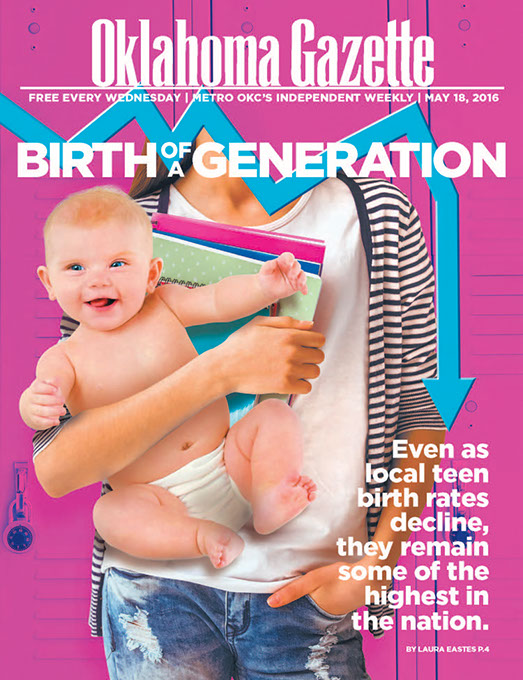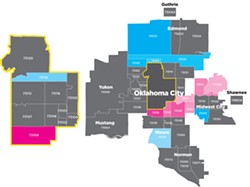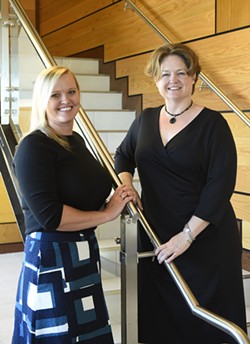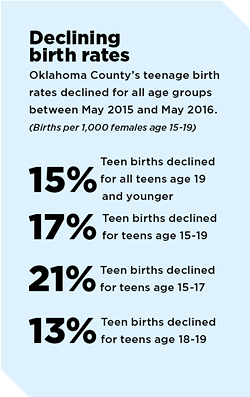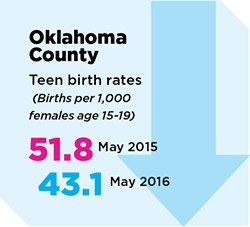When teenagers Katia Harms and Zoe White recounted their first discussions with adults about sex, the two friends described bewildering and painful experiences as fifth-graders at a south Oklahoma City school.
“They made it a big deal,” said Harms, now a Norman North High School freshman, “all the boys in one room and the girls in another.”
Explained White, a Southmoore High School freshman, “We were told not to talk to the other gender after or we would get in serious trouble.”
Harms added, “It was really uncomfortable. No one asked questions; it was deadly silent in the room.”
The teens made no mention of what they learned during those sex ed presentations four years ago at Briarwood Elementary School. Instead, they narrate a school experience that left them with an overwhelming sense of shame and confusion about their curiosity. They wanted to know more about sexual health education, but the course was taught differently than math or science lessons. As a result, the youths felt awkward and uneasy asking questions.
They believe they weren’t the only students who felt that way. Naturally, teens are curious about sex and want to know and understand the risks involved, they explained. Often, youths are uncomfortable talking to parents, teachers, physicians and even their peers about sexual health.
The truth
Teens just want facts, White said: “They don’t know whom to ask or how to get the correct information.”
Ariana Hall relates to the anxiety, fear and reluctance preteens and teenagers feel about asking parents, older family members, mentors or teachers about “the birds and the bees.” Hall did not receive basic sexual health and hygiene education in school, nor did adults talk to her about her body, how it changes or how sexual health plays a role in those developments.
In the fall of 2013, Hall became a peer educator for Teen emPower!, a pro-prevention and teen health education program serving area middle schools. For the first time, the Del City High School senior had the knowledge she needed to make informed decisions about her body and sex.
“We all have so many questions, but we are scared to ask,” Hall said. “There were so many questions I had about myself and my body. It was simple, but I was afraid to ask my parents because I thought it was shameful. I didn’t learn about myself until I learned how to teach other people about themselves.”
As a University of Oklahoma student, Hall encounters classmates who never received in-depth or basic sex education in middle or high school. Hall discovered some of her peers know very little, if anything, about maintaining their sexual health. She believes they are susceptible to unhealthy relationships and lack the tools to understand and enforce personal boundaries.
“There are people in college who don’t know a thing about their bodies,” Hall said. “I’ve learned so much from [Teen emPower!], including being able to talk to people that are in their 20s and say, ‘Hey, it is OK to ask questions about your body.’”
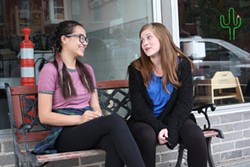
Evidence-based education
The three central Oklahoma teens’ insights into their first sex talks illustrate the need for youth organizations, schools, parents, community members and medical professionals to develop and enable more realistic, common sense-based sexual health education programs for youths.
Research supports that evidence-based sex education programs help teens remain healthy and avoid negative sexual health outcomes. Oklahoma does not mandate sex education in public schools, leaving school boards the option to ignore, enact or support education efforts by outside groups. The result is a hodgepodge of approaches in schools across the state, varying from no programs to abstinence-only lessons or condom demonstrations.
Indeed, Oklahoma teens are having sex. In a Centers for Disease Control and Prevention (CDC) report, 50.1 percent of Oklahoma high school students reported they have “ever had” intercourse, slightly higher than the national median response of 43.4 percent. Similarly, Oklahoma reports high numbers of teen births. Locally, Oklahoma County’s teen birth rate also is higher than the national average. (Oklahoma Vital Statistics data tracks live births, not pregnancies.)
Advocating change
In central Oklahoma, nonprofit and state organizations such as Kirkpatrick Family Fund, Variety Care, Oklahoma City-County Health Department (OCCHD), Oklahoma Institute for Child Advocacy and Teen emPower! work together to spark teen sex education dialogues and advance community conversations about sexual health education and teen births.
Central Oklahoma Teen Pregnancy Prevention Collaboration, an alliance, works to promote reproductive health among teens and decrease teen birth rates. A year after releasing As a Matter of Fact, its in-depth plan to address teen pregnancy in central Oklahoma, the alliance reported a 17 percent decrease in Oklahoma County’s teen birth rate.
Oklahoma’s birth rates are still some of the highest in the nation, according to National Center for Health Statistics data. Due to this fact, over the next five years, millions of federal dollars will flow into the Sooner state to reduce teen pregnancy and birth rates. U.S. Department of Health and Human Services grant funding, coupled with strategies identified in Central Oklahoma Teen Pregnancy Prevention Collaboration’s plan, put central Oklahoma in a unique position to further curb teen pregnancy and shape the community’s future, said Sheila Cavallo, project manager for Oklahoma County’s TPP Tier 1B Project (the federal grant).
“I think Oklahoma is almost seen as a cautionary tale,” Cavallo said. “I think we are going to flip that. We are going to stop being this cautionary tale and become the model for how you take a situation that seems like it can’t be fixed and turn it around. We are already headed in that direction.”
A year ago, Oklahoma County’s teen birth rate was listed as 51.8 live births per 1,000 females. Currently, the rate stands at 43.1 live births per 1,000 females.
By comparison, the nation’s teen birth rate was 24.2 live births per 1,000 females in 2014, according to CDC data.
No ‘silos’
A decade ago, Kirkpatrick Family Fund trustees took note of the state’s high teen birth rate, which, in 2006, increased for the first time in more than 15 years. At that time, the rate was 59.7 per 1,000 females age 15-19, according to Oklahoma Vital Statistics data.
Kirkpatrick Family Fund mobilized, joining with organizations already working to prevent teen pregnancy.
“Kirkpatrick Family Fund brought partners to the table, and those partners made a conscious decision that we were no longer going to work in silos,” said Cavallo, who previously worked with Oklahoma Institute for Child Advocacy. “We were going to work together and leverage our resources. We were going to be intelligent about this. That gave rise to what is now a formalized collaboration.”
From 2006 to 2012, the collaborative grew its teen health education efforts from two health educators visiting two schools to more than a dozen health educators working in 15 schools. The efforts also influenced eight clinics to provided teen-friendly reproductive health services and contraceptive care. In 2012, organizers looked outside of Oklahoma, closely studying efforts in Milwaukee, Wisconsin, where teen pregnancy was reduced by more than 50 percent in four years.
Milwaukee’s success centered on partnerships, focused on evidence-based programs and set community goals, which confirmed the Oklahoma collaboration was on track to improve central Oklahoma, explained Tina Burdett, Kirkpatrick Family Fund senior program officer.
“A coordinated community initiative could actually make a difference,” Burdett said. “Not just a nominal difference, but have a substantial impact on the issue.”
Three years later, Kirkpatrick Family Fund and Central Oklahoma Teen Pregnancy Prevention Collaboration released their As a Matter of Fact plan. The three-part plan examined schools, the community and the medical profession. It was tailored to address the needs of the diverse Oklahoma County community. Each component included strategies to bring about change, such as creating and improving teen-friendly clinics, expanding evidence-based sex education curriculum in schools and delivering resources in community settings.
The plan addressed challenges faced by OCCHD and other partners when tackling the high teen birth rate, said Linsey Garlington, OCCHD teen pregnancy prevention supervisor.
“There is a lack of education around reproductive health and health relationships. We are addressing that,” Garlington said. “There is a lack of teen-friendly clinics for teens to go for services. We are addressing that. We are building in a community capacity that this is an issue and we need to be aware of it … and not let it become an accepted reality.”
Costs, consequences
Teen pregnancy prevention has been a top priority for the Oklahoma Institute for Child Advocacy since the 1990s, said Sharon Rodine, the institute’s youth initiatives director.
“The costs and consequences of too-early parenting impact such a wide range of health, education, economic well-being and family stability issues,” wrote Rodine in an email to Oklahoma Gazette. “Reducing teen pregnancy reduces school dropout, child abuse and neglect, generational poverty and lifelong health complications for the mother and baby — increasing school readiness, graduation preparation and family stability, among many issues.”
In the United States, 38 percent of teen girls who have a child before age 18 obtain a high school diploma by age 22. Less than 2 percent of teen moms who graduate high school earn a college degree by age 30, according to studies cited by the National Campaign to Prevent Teen and Unplanned Pregnancy.
The CDC found children born to teen moms are more likely to have behavioral problems and chronic medical conditions. Additionally, teen moms are more likely to utilize public assistance to help them afford health care, and other research shows teen moms also seek aid from nonprofits, charities, other assistance programs and family members.
The most recent study showed that teen childbearing in Oklahoma cost taxpayers at least $169 million in 2010. However, few taxpayer dollars are allocated for expanding education to prevent teen pregnancies, according to Rodine.
“This is an economic development issue for our communities and our state,” Rodine wrote in her statement to the Gazette. “We live in an increasingly competitive, tech-focused economy that requires an adaptable, skilled workforce. Oklahoma has had one of the highest teen birth rates in the country over the past decade, due to a lack of investment of resources statewide in prevention efforts proven to be effective.
“Other states — our competitors in the national and global marketplace — [are focusing] on expanding quality, relevant prevention programs; providing training and resources to support health education; and encouraging community partnerships and coordination to ensure more young people finish their education and start their career before starting a family.”
Burdett also sees teen pregnancy as part of a broader community issue.
“Oklahoma City has emerged as a world-class community, but a world-class community doesn’t have one of the highest teen birth rates in the United States,” Burdett said. “For Oklahoma City to really own and celebrate the extraordinary achievements we have had across all sectors, we must, as a community, take on this issue.”
Solution components
In 2006, Kathy Harms entered a seventh-grade classroom at Crooked Oak Public Schools, a small district located in southeast Oklahoma City. The mother of three spoke about sexual health education to 12- and 13-year-olds. She created Teen emPower! from her own desire to see lessons and discussions in OKC metro schools on puberty, reproductive health, contraception and sexually transmitted diseases. Her approach isn’t pro-life or pro-choice; it is pro-prevention.
“What it boils down to is giving them the facts, the information,” said Harms, Katia Harms’ mother, “and not making them feel bad or weird.”
The program serves middle school students in Crooked Oak, Oklahoma City and Mid-Del districts.
Typically, early in her lessons, she hears snickers and nervous laughter when she uses anatomical terms such as penis and vagina. As the class progresses, students become more at ease and begin asking questions and making comments. One comment she hasn’t forgotten came from a seventh-grade girl, who said all her friends were “doing it,” but she wanted to wait until she was 15.
“Kids are just trying to navigate life,” Harms said. “What we give them is another perspective. We never go in and say, ‘Don’t do this’ or ‘Do this.’”
After five lessons, she introduces peer educators, high school students trained to act out situations that teens commonly face. Peer educators explain healthy relationships, personal boundaries and ways to say no while maintaining friendships and relationships.
For students and peer educators to participate in the class, parents must sign permission slips, which also connect parents to Harms. Many question the messages their child might hear. Some believe seventh grade is too early for sexual health education. Harms said fears are quelled when parents agree their child would benefit from a sex education program that discusses abstinence but also provides facts on contraception.
OCCHD provides area schools and youth programs a quality, age-appropriate, evidence-based sex education curriculum that also emphasizes healthy relationships, decision-making and goal setting.
“Young people connect with our educators and look forward to them coming into their classrooms,” Garlington said. “They are always disappointed when the program is over; even the students who sat in the back of the room and remained quiet.”
At Variety Care, a nonprofit community health center with locations in the metro, pediatrician Kyle Stewart looks for opportunities to reach teens by discussing reproductive health and prevention of unplanned pregnancy with his teen patients. His clinic is considered teen-friendly, which means staff spends time with teens to answer questions and set patient appointments right away. If youths suspect they are pregnant or desire contraception, they don’t want to wait several weeks for an appointment.
“Unfortunately, a lot of clinics don’t really enjoy teens,” Stewart said, describing the need for more teen-friendly clinics. “Teens take more time. They are not a lucrative patient population. It’s not malicious, but a lot of times, when you are churning patients in and out, you wouldn’t take the time to talk through screening for sexually transmitted infections or help a teen think about their relationship. You’re not going to encourage abstinence or talk about contraception.”
More work
A 17 percent reduction in the teen birth rate over 12 months confirms the collaborative is headed toward reaching a goal to reduce teen births by one-third between 2015 and 2020, Burdett said.
“We see data that support the successes that we see in the classrooms and the support we see from members of our community,” Burdett said. “We knew the strategies that we were adopting were based on best practices and were custom to fit the needs of young people in central Oklahoma.”
Prevention efforts intensify in year two of the plan. Through the $6 million federal grant, OCCHD will push more evidence-based education, prevention and medically accurate programs into 10 Oklahoma County ZIP codes with the highest rates of teen births. Those ZIP codes are located in parts of south and central Oklahoma City and northeast Oklahoma County.
Additionally, the collaborative will establish a Youth Leadership Council in which teen members will help design, plan and implant community teen pregnancy awareness programs.
For teen pregnancy prevention at community college and post-secondary institutions, the National Campaign to Prevent Teen and Unplanned Pregnancy plans to work with Kirkpatrick Family Fund to create programs to help older teens avoid unplanned pregnancies.
All community members can play a role in educating the next generations about sexual health and healthy relationships, said Stewart, who mentors to teens outside of his work with Variety Care.
“The faith communities and the families are the sleeping giants in getting these conversations going,” said Stewart, who said most of his teen patients say they don’t talk about sex with family members or in faith settings. “It would be great for me, as a doctor, to just put the cherry on top when they come into the clinic with answering questions. Most of the time, when I see teens, we are starting from zero.”
Harms starts at zero with many of her students; however, she encourages dialogues to continue at home.
“A vast majority don’t want to have these conversations with their parents because they are afraid their parents are going to think they want to have sex,” Harms said. “I tell them, ‘Go home and share what you learned in class.’ That opens the conversation.”
Print Headline: Conversation starter, In a state where the majority of teens are sexually active and a high number of them give birth, it’s time to change how sexual health education is taught.

